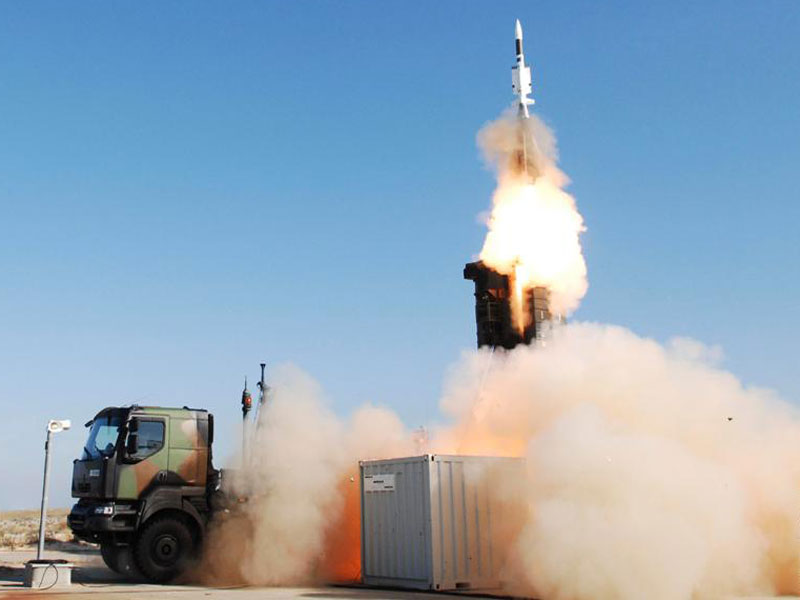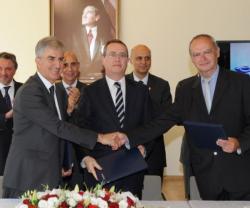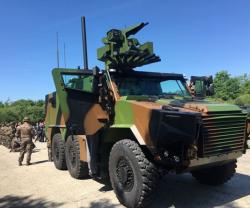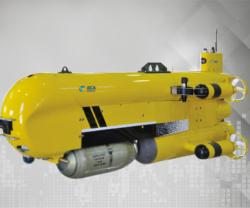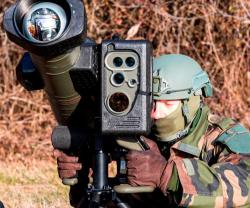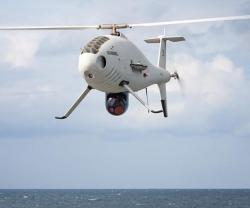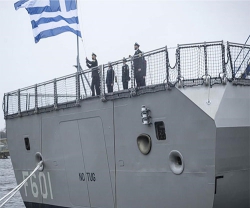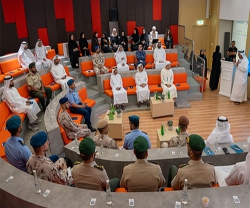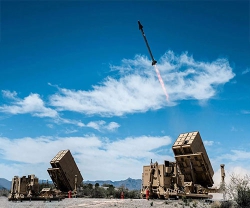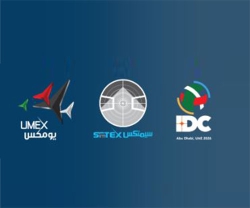EUROSAM SAMP/T Scores Again
11.03.2013 Europe
On March 6th 2013, the SAMP/T system scored a new success. A joint team of French and Italian crew operating 2 French Air Force SAMP/T units conducted a test fire against a ballistic threat.
This was the third time that SAMP/T proceeded to a test firing against such type of threat, the second time by an operational crew. The test took place in CELM (South West of France), the DGA firing polygon. Like the previous ATBM firings, in October 2010 and November 2011, the target, air launched, was representative of a 300 km range TBM threat.
The differences with the previous ATBM intercept were significant, though. This firing was a premiere in several ways. On the one hand it was the first SAMP/T firing using L16 for data links with the higher echelons.
On the other hand, while the previous 2 ATBM tests were conducted in a French specific environment, wholly controlled by DGA and French Air Force, this latest one can be called the first SAMP/T firing test in a NATO environment, close to what would be an operational use for an ATBM mission under the aegis of the alliance ALTBMD program. NATO BMDOC, located in Ramstein, was in the loop via L16 network. Last but not least, though the ground equipment was provided by French Air Force, the crew was a mix of Italian Army and French Air Force personnel, a token of the long lasting cooperation between the 2 Nations in developing, building, testing and fielding SAMP/T.
DGA sensors did provide the firing units and the command levels long-range detection data on A L16 radio network. DGA MI, in Bruz, acted as a L16 national C2, interfacing in L16 both with NATO BMDOC, via L16 JREAP and with SAMP/T. Once target was acquired by the ARABEL multi-function radars of the 2 SAMP/T deployed, the test scenario unwound according to plan: one of the 2 SAMP/T of the deployment was selected and the ASTER 30 B1 missile fired did score a direct hit against the ballistic target.
It is the second direct hit in 2 ATBM test firings by SAMP/T end user. It is also the 13th SAMP/T firing success in a row, an uninterrupted series since system qualification firings started back in 2005, followed by operational forces firings, since 2008.
SAMP/T is the only non-US built long-range air defense system contributing to the NATO Alliance capability against ballistic threats. French and Italian governments have committed to contribute to NATO ATBM defense with SAMP/T systems. NATO, Italian and French high-level representatives witnessed the test in CELM, as well as NATO personnel in Ramstein, thanks to the L16 data exchange.
Eurosam has delivered to date 14 units to Italy and France, including 2 First of Class units. France will deploy 10 SAMP/T in 5 air defense squadrons, 4 of which are currently equipped or being equipped. The Italian Army will regroup 5 SAMP/T units in one Regiment, in Mantova, with 4 already delivered.
This was the third time that SAMP/T proceeded to a test firing against such type of threat, the second time by an operational crew. The test took place in CELM (South West of France), the DGA firing polygon. Like the previous ATBM firings, in October 2010 and November 2011, the target, air launched, was representative of a 300 km range TBM threat.
The differences with the previous ATBM intercept were significant, though. This firing was a premiere in several ways. On the one hand it was the first SAMP/T firing using L16 for data links with the higher echelons.
On the other hand, while the previous 2 ATBM tests were conducted in a French specific environment, wholly controlled by DGA and French Air Force, this latest one can be called the first SAMP/T firing test in a NATO environment, close to what would be an operational use for an ATBM mission under the aegis of the alliance ALTBMD program. NATO BMDOC, located in Ramstein, was in the loop via L16 network. Last but not least, though the ground equipment was provided by French Air Force, the crew was a mix of Italian Army and French Air Force personnel, a token of the long lasting cooperation between the 2 Nations in developing, building, testing and fielding SAMP/T.
DGA sensors did provide the firing units and the command levels long-range detection data on A L16 radio network. DGA MI, in Bruz, acted as a L16 national C2, interfacing in L16 both with NATO BMDOC, via L16 JREAP and with SAMP/T. Once target was acquired by the ARABEL multi-function radars of the 2 SAMP/T deployed, the test scenario unwound according to plan: one of the 2 SAMP/T of the deployment was selected and the ASTER 30 B1 missile fired did score a direct hit against the ballistic target.
It is the second direct hit in 2 ATBM test firings by SAMP/T end user. It is also the 13th SAMP/T firing success in a row, an uninterrupted series since system qualification firings started back in 2005, followed by operational forces firings, since 2008.
SAMP/T is the only non-US built long-range air defense system contributing to the NATO Alliance capability against ballistic threats. French and Italian governments have committed to contribute to NATO ATBM defense with SAMP/T systems. NATO, Italian and French high-level representatives witnessed the test in CELM, as well as NATO personnel in Ramstein, thanks to the L16 data exchange.
Eurosam has delivered to date 14 units to Italy and France, including 2 First of Class units. France will deploy 10 SAMP/T in 5 air defense squadrons, 4 of which are currently equipped or being equipped. The Italian Army will regroup 5 SAMP/T units in one Regiment, in Mantova, with 4 already delivered.
Previous PostSaab Acquires Ballistic Protection Technology
Latest news
Latest events
Doha International Maritime Defence Exhibition & Conference (DIMDEX 2026)
19 - 22 Jan 2026Doha - QatarUMEX – SimTEX
20 - 22 Jan 2026ADNEC Centre Abu Dhabi, - United Arab EmiratesWorld Defense Show (WDS) 2026
08 - 12 Feb 2026Riyadh - Saudi ArabiaSAHA EXPO International Defence & Aerospace Exhibition
05 - 09 May 2026İstanbul Expo Center - Turkey

